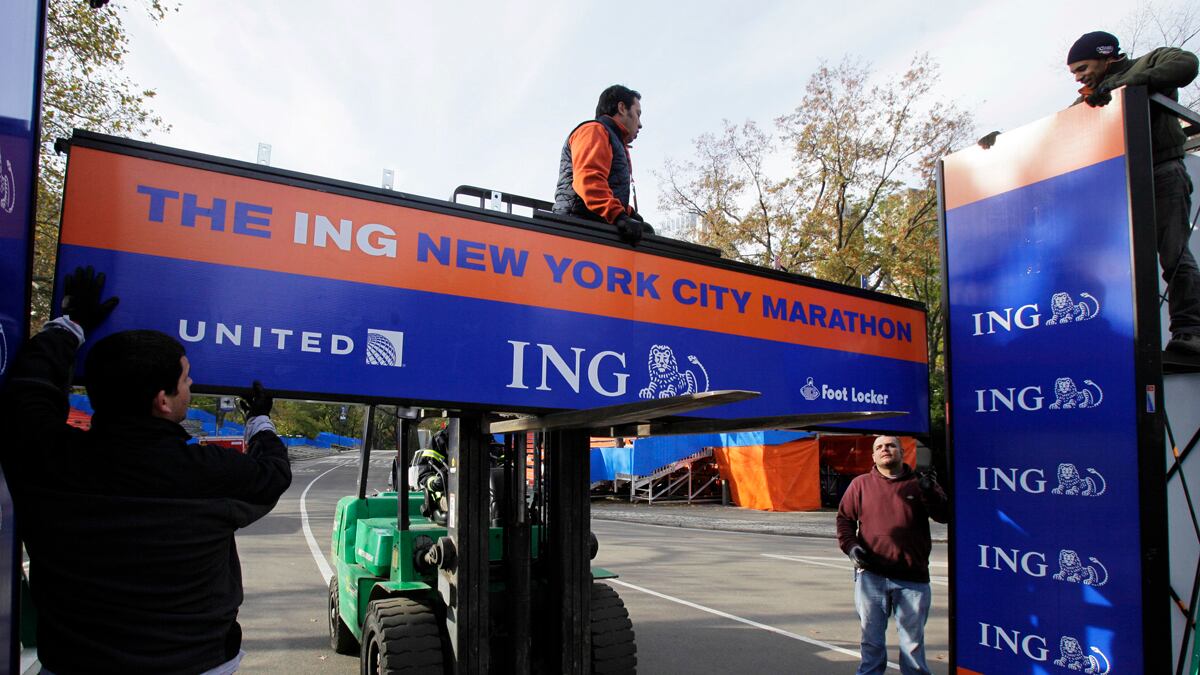Tens of thousands of runners are set to begin the 43rd annual ING New York City Marathon at Fort Wadsworth at the mouth of the Verazzano-Narrows Bridge on Staten Island early Sunday morning. But local politicians, New Yorkers—especially Staten Islanders, some of whom who’ve had their homes and businesses destroyed by Hurricane Sandy, and many who have been without electricity and water for days—and even diehard marathoners don’t want them there.

“My God!” exclaimed Staten Island Borough President Jim Molinaro in a press conference on Wednesday. “What we have here is terrible, a disaster. If they want to race, let them race with themselves. This is no time for a parade. A marathon is a parade.”
New York City Mayor Michael Bloomberg triumphantly announced Wednesday that the marathon would go ahead as scheduled Nov. 4, six days after Hurricane Sandy tore the metropolitan area to shreds, killing 38 in the city alone, ruining homes and businesses in low-lying areas and cutting out power for millions.
ADVERTISEMENT
“It’s a great event for New York,” Bloomberg said during a press conference. “And I think for those who were lost, you know, you’ve got to believe they would want us to have an economy and have a city go on for those that they left behind.”
The New York Road Runners, which organizes the marathon, tried to curb the backlash Thursday by introducing a program called The Race to Recover, with an initial $1 million donation.
Bloomberg also tried to calm angry New Yorkers at a news briefing Thursday, announcing that an “enormous amount of police” would be available at the marathon, since the power was expected back on in downtown Manhattan by Saturday.
Two of the marathon’s events, the Opening Ceremony and 5K Dash to the Finish Line, were canceled. Road Runners’ leadership wasn’t able to comment for this article.
Excited volunteers and runners seemed unfazed by the controversy at the marathon’s Health and Fitness Expo at the Javits Center in Midtown. Volunteers in orange caps and T-shirts handed out ING merchandise and runners snapped photos of themselves in front of mockups of the marathon route.
Runners across the city who had been prepping for the marathon for months were startled by the notion that they were suddenly the villains of Hurricane Sandy.
“I definitely thought twice about running,” says Claire Sabel, a first-time marathoner who has been training since the summer. “But I don’t think people who run the marathon are running purely for themselves. It’s about raising money for charity and New York coming together. Those causes don’t just stop.”
Lee Silverman, the owner of JackRabbit Sports, a sporting-goods chain in New York, argued that charities that could help communities recover after Sandy, like the Red Cross, might even lose money if the marathon is canceled.
“I think peoples’ emotional response to the marathon will be different on Sunday than it was on Tuesday,” Silverman added. “Already today the feeling in the city is, ‘all right, let’s get back to work.’” Silverman said 500 people showed up to help at the expo after JackRabbit sent out an email to customers asking for volunteers.
The marathon, which typically draws more than 100,000 applicants each year, hasn’t been canceled since the first race in 1970. Six weeks after the Sept. 11 attacks, the marathon was considered a show of resilience by New Yorkers. A spokeswoman for Road Runners pointed out that the marathon typically rakes in serious money for the city and for charity—in 2011, the marathon brought in $340 million in local revenue and $34 million for charity.
And this year, the Road Runners, not the city, will have to foot the bill for the cops, emergency workers, and traffic controllers who make the marathon run smoothly—which will cost about $2.5 million, according to Crain’s.
But the backlash against the marathon doesn’t seem to be going anywhere.
A virtual battle was being waged in hundreds of comments on the marathon’s Facebook page. “Sorry, it is an INSULT to run this marathon,” wrote one user. “All the negativity on this page is discouraging until I remind myself that the whiners are really only a very small sliver of the runners, volunteers, and thousands of others who will be involved with the race in some way,” another countered.

Politicians across the five boroughs have condemned Bloomberg and Road Runners for going ahead.
“I do appreciate that the marathon brings in money to local business, but let’s be honest, it’s a huge draw on our resources,” State Senator Liz Krueger told The New York Times. “None of the boroughs is near up and running,” she added.
State Senator Andy Lanza called the decision to go ahead with the race “disgusting.”
“I think this is an example of what infuriates people here on Staten Island,” said local congressman Michael Grimm. “We’re not back to normal and we’re not going to be back to normal for a long time.”
More than 50 percent of respondents to a Staten Island Advance poll said running the marathon was “a disgrace, and an insult to every New Yorker who has suffered in any way.”
Even some of the city’s most dedicated runners are joining the chorus of New Yorkers calling on Bloomberg to cancel the race. “Even I can see that there are more important things to focus on right now,” says Jon Crane, a fitness coach at City Coach. Crane has run the marathon himself and spends his days training runners for the race.
Even so, he says, “I just think it’s too soon.”
—With additional reporting by Matt De Luca






